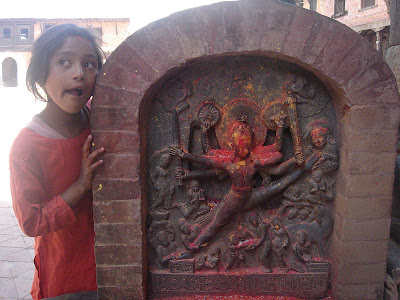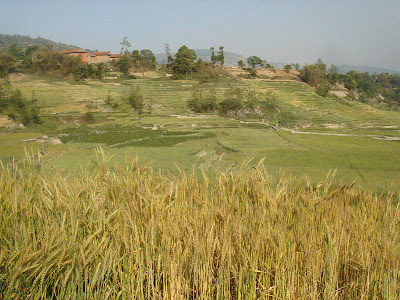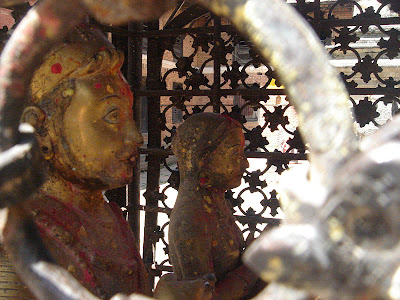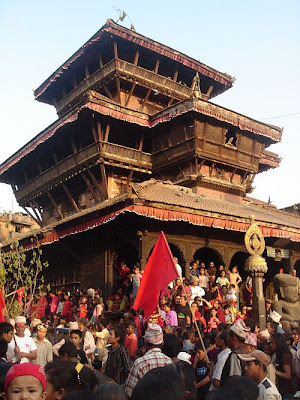Power Places Part ThreeBhaktapur, Changu, and Kathmandu, Nepal
 The morning after the insane tug-of-civil war that is Bisket Jatra in Bhaktapur (half the town goes to war with the other half the town trying to pull the chariot apart, or so it would seem), I met a couple of Americans who also wanted to go up to the hillside temple of Changu Narayan (one of the "Power Places of the Kathmandu Valley"). It is believed to be the very oldest temple in the valley, and also has the oldest inscription yet located here - from the 3rd century AD, in Licchavi script. (The Licchavis were one of the Indian Hindu dynasties who came up from Magadha way, I think.)
The morning after the insane tug-of-civil war that is Bisket Jatra in Bhaktapur (half the town goes to war with the other half the town trying to pull the chariot apart, or so it would seem), I met a couple of Americans who also wanted to go up to the hillside temple of Changu Narayan (one of the "Power Places of the Kathmandu Valley"). It is believed to be the very oldest temple in the valley, and also has the oldest inscription yet located here - from the 3rd century AD, in Licchavi script. (The Licchavis were one of the Indian Hindu dynasties who came up from Magadha way, I think.) 
Lynette, Dave and I decided to do the ultra budget thing and catch the local bus up to Changu, rather than pay the inflated taxi prices (300NRs or five dollars! please, it costs 600 to go all the way back to Kathmandu. Changu is only 15 minutes away by car).
There are about five different bus stops (or 'bus stands' as they are called here - "tourist bus park," "Mini bus park" etc) in Bhaktapur, so to determine the right one, we had to wander through the hand-hewn brick and wood labyrinthes of Bhaktapur asking directions, which is part of the fun. "Changu bus stand?" is the best way to phrase the question. When we just said "Changu?" people pointed in the direction of Changu itself, which doesn't necessarily help you get the bus.
The road to Changu from Bhaktapur (the back road, not the driveable highway) would be a very nice walk - taking about 2 hours - if we had started early enough in the morning. As it was after 11am, it was already boiling hot. Don't be fooled by the clothing you see on the local people - they have the maddening ability to wear long sleeves, synthetic fibres, and even several layers, in the pre-monsoon swelter and barely break a sweat.
When we finally located the place everyone insisted was the "Changu bus stand," a taxi driver pulled up and did his very best to persuade us that in fact, there was NO bus to Changu. "No Changu bus. No bus. No bus today. Taxi, 300 Rs only." (By the way, the bus is 10NRs.) Instantly the shop owners, whose shop we were standing in front of, tried to get in on the act. They too insisted there was "no bus."
I had gotten the driver down to 200NRs and was trying to beat him down for 150 when we noticed a small crowd of people - women, children, and elderly - gathering on the corner diagonally opposite.
"I bet THAT's where the bus leaves from." I hopped across the smelly grey open sewer ditch and strode across the road. "Changu Bus?" I asked the young girls in kurta-surwal. They all nodded.
The taxi driver, as usual in such situations, displayed no trace of shame or embarassment at his "no bus" lies, shrugged and sped off.
The bus was so crowded, we elected to sit on top. This is by far the best and best-ventilated way to travel, especially in hot sweaty summer, but is considered unorthodox for women. As foreign women, Lynette and I were somewhat exempt from the etiquette and clambered up the metal ladder to the bus roof - where the view is unsurpassed.

We were joined by half a dozen young boys till the tiny luggage-rack railing was crammed with humans. I made sure to get in the middle, sharing space with an empty red metal gas cylinder and a worn spare tire, where it seemed less likely I'd fall off. We need not have worried about falling - the bus creaked along slowly through wheat fields up the hillside.

 Our fellow roof-riders seemed well-informed about the upcoming US elections and wanted to know "Who will be the next president of your country?"
Our fellow roof-riders seemed well-informed about the upcoming US elections and wanted to know "Who will be the next president of your country?" As usual in this part of the world, the name "Cleenton" evoked the most recognition - a trusted brand name on the subcontinent.
Changu Narayan has got to be one of the most reasonable entrance fees in all of Asia - 60NRs or exactly $1.00 US to see the oldest temple in the Valley (and the one best noted for its sculptures).

The last time I came was in September during the misty post-monsoon. I walked down from Telkot through damp pine forests that felt more like Scotland than Nepal. This ascent couldn't have been more different, in the hot dry season. However, it did mean this time I could take photos.
The isolated location of Changu Narayan means it's the least visited of the UNESCO World Heritage Sites in the Valley. It also means there are fewer tourists, which is both good and bad. It's never crowded, but ALL the attention of the shopkeepers, begging kids and touts was focused on US, the lone foreigners.

Changu displays a familiar Nepali combination - a rich upwelling of devotional energy manifested in myriad curlicues, psychedelic flourishes and startling chimeric beasts that defy description...lots of decay...and lots and lots of pigeon doo. In fact, a case could be made that the pigeon droppings rival the air pollution for destruction of the monuments. I can't support killing the pigeons outright, but I would definitely get behind a plan for pigeon birth control. (A few pigeons taking flight from the square in the morning light is nice. Hordes of them all over is a health and architectural hazard.)

Despite the fact that I can't read it, I think the stone below is my favorite part of Changu. In the ancient and now disused
Licchavi script, it supposedly relates the story of how a Licchavi king dissuaded his mother from
sati, or widow's ritual suicide on the funeral pyre of her husband, and instead persuaded her to stay with him among the living because he would miss her. (Some proof that, despite what many would like to claim,
sati was real, not an invention of the British or anti-Hindu propagandists.)

Narayan is one of the names of Lord Vishnu, who represents the "preserver or maintainer" form of the Godhead. This is the aspect of god traditionally meant to be embodied in the King of Nepal, though the current candidate seems to have been asleep at the switch. Though we weren't able to see the murti or statue inside ("Hindus only"), there are plenty of surrounding toranas (engraved and embossed metal archways), friezes, and sculptures. Most of them depict the various DasAvatar or ten earthly incarnations of Vishnu, including Lord Krishna, the dwarf manifestation whom I think was called Vamana, Parashurama, Narasingha the man-lion avatar disemboweling a nonbeliever (below), and what looks like Vishwarupa (the overwhelming all-encompassing universal form of God), a masterpiece of mind-boggling Hindu psychedelia depicting the three worlds (of the underworld, men and gods, below).
Despite having been damaged during an attempted robbery, the detailed cosmology of Vishwarupa is well worth a few minutes' contemplation. I'm afraid the photos really don't do the sculptures justice. There is a legend accompanying each of the statues - I know most of them and was able to bore Lynette and Dave with my know-it-all stories, but there is no printed guide available so you should bring a guidebook with details to Changu Narayan.



Isolated in their gilded cage are small statues of a former Licchavi King and Queen, possibly the ones who built the actual Changu Narayan temple (the site is believed to have been used for worship long before the building was erected). This is a common feature of Nepali temples - the patron king and queen immortalizing themselves in the kneeling posture of devotion, hands folded in salutation, facing the deity. 
 After a dreadful and very overpriced lunch at the neat, tidy garden style restaurant near the front gate (don't be fooled by the appearance - they do have a bathroom, though), we elected to walk the hour and half back down to Bhaktapur town, through the pine forest (the best part), windy wheat fields, and dusty small towns.
After a dreadful and very overpriced lunch at the neat, tidy garden style restaurant near the front gate (don't be fooled by the appearance - they do have a bathroom, though), we elected to walk the hour and half back down to Bhaktapur town, through the pine forest (the best part), windy wheat fields, and dusty small towns.
We knew we were near "town" when speeding vehicles threatened to knock us off the road into the ditch, and choked us with their fumes. Back in Bhaktapur, we were greeted by still more clanging cymbals, beating of drums and tooting of flutes. Was Bisket Jatra STILL going on? 
It turned out to be a different festival. The Maoists, along with a local affiliate Newar identity party, were celebrating their electoral victory with traditional music, traditional dance, red banners and portraits of Stalin, Mao, Marx and Lenin.

 Dattatreya Temple square (also called Tachupal) was once surrounded by Maths, or Hindu ashram-style centres of residential learning. Students came from all over the region to learn traditional Ayurvedic (herbal) medicine in the ornately carved wooden buildings. Now, Pujari Math is a woodcarving museum, and another of the Maths has been transformed into a high-priced tourist restaurant.
Dattatreya Temple square (also called Tachupal) was once surrounded by Maths, or Hindu ashram-style centres of residential learning. Students came from all over the region to learn traditional Ayurvedic (herbal) medicine in the ornately carved wooden buildings. Now, Pujari Math is a woodcarving museum, and another of the Maths has been transformed into a high-priced tourist restaurant.
New gods were being worshipped in the old square. It was high time for a shower and a pot of tea. We drifted through the narrow streets floating among political icons, Buddhist statues and Hindu gods back to the Bhadgaon Guest House.
---Thanks to Sudarshan for correcting some of the deity information.




 Our fellow roof-riders seemed well-informed about the upcoming US elections and wanted to know "Who will be the next president of your country?" As usual in this part of the world, the name "Cleenton" evoked the most recognition - a trusted brand name on the subcontinent.
Our fellow roof-riders seemed well-informed about the upcoming US elections and wanted to know "Who will be the next president of your country?" As usual in this part of the world, the name "Cleenton" evoked the most recognition - a trusted brand name on the subcontinent. 

 Despite the fact that I can't read it, I think the stone below is my favorite part of Changu. In the ancient and now disused Licchavi script, it supposedly relates the story of how a Licchavi king dissuaded his mother from sati, or widow's ritual suicide on the funeral pyre of her husband, and instead persuaded her to stay with him among the living because he would miss her. (Some proof that, despite what many would like to claim, sati was real, not an invention of the British or anti-Hindu propagandists.)
Despite the fact that I can't read it, I think the stone below is my favorite part of Changu. In the ancient and now disused Licchavi script, it supposedly relates the story of how a Licchavi king dissuaded his mother from sati, or widow's ritual suicide on the funeral pyre of her husband, and instead persuaded her to stay with him among the living because he would miss her. (Some proof that, despite what many would like to claim, sati was real, not an invention of the British or anti-Hindu propagandists.)




 After a dreadful and very overpriced lunch at the neat, tidy garden style restaurant near the front gate (don't be fooled by the appearance - they do have a bathroom, though), we elected to walk the hour and half back down to Bhaktapur town, through the pine forest (the best part), windy wheat fields, and dusty small towns.
After a dreadful and very overpriced lunch at the neat, tidy garden style restaurant near the front gate (don't be fooled by the appearance - they do have a bathroom, though), we elected to walk the hour and half back down to Bhaktapur town, through the pine forest (the best part), windy wheat fields, and dusty small towns. 

 Dattatreya Temple square (also called Tachupal) was once surrounded by Maths, or Hindu ashram-style centres of residential learning. Students came from all over the region to learn traditional Ayurvedic (herbal) medicine in the ornately carved wooden buildings. Now, Pujari Math is a woodcarving museum, and another of the Maths has been transformed into a high-priced tourist restaurant.
Dattatreya Temple square (also called Tachupal) was once surrounded by Maths, or Hindu ashram-style centres of residential learning. Students came from all over the region to learn traditional Ayurvedic (herbal) medicine in the ornately carved wooden buildings. Now, Pujari Math is a woodcarving museum, and another of the Maths has been transformed into a high-priced tourist restaurant. 













5 comments:
my theory of why they call "bus STOP" "bus STAND" in Nepal is that in Nepali "bus" means sit, so if you're in a "bus STOP" you are very unlikely to get anywhere :)
and top of the bus is definitely the best seat for local travels in Nepal in summer. reading your observations reminds me of the two years i lived in Bhaktapur in the mid-90s. it must have changed a lot since then, but looking at your pictures (in previous posts) it seems a lot of the things are still the same!
What a wonderful post. Thank you so much SS.
Siren
It is interesting you came up on the Lichchavi culture. From what I have read, the Lichchavi kingdom used to practice Democracy even before the Greeks, who are often credited with discovering democracy. It is supposed to be a very ancient culture.
Narayan in sanskrit means "Indestructible" He is not just the "preserver" but the Nepali's believe that He is the Lord of the Universe. By the way, Mahabali is an asura king, but a devotee of Vishnu. He is not an avataar of Vishnu. Parasurama, Narasimha, etc. are.
regards
Sudarshan
@Sudarshan: That's right, Mahabali was the name of the Ashura King who was trumped by Vishnu. But what was the name of the dwarf incarnation of Vishnu who covered the world with three steps?? I think it was Vamana.
The Greeks are not credited with "discovering" democracy, but with inventing it. Certainly other societies had forms of democracy at other times. But the form that came to Western civ. came via Greek civilization. It could be said that they gave democracy to the West, if not elsewhere.
Yes, it was Vamana.
Post a Comment